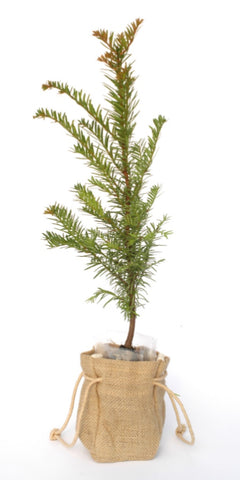Yew Tree Facts and Information
- Latin name: Taxus baccata
- Native words: Old Irish (ibar), Scots Gaelic (iubhar), Old English (eow), Welsh (ywen), Eastern Celtic (iw)
- Ogham sign: I
- Height when mature: 25m (82ft)
- Height after 10 years: 1–2m (3–6ft)

Yew Tree Botanical Description
Yew trees, like Beech and Rowan, are among the few British native trees capable of growing in deep shade.
As an evergreen species, Yew has needle-like leaves arranged in two flat rows along the twig, dark green on top and light green beneath. The leaves are waxy to the touch.
Its trunks are often fluted with reddish-brown, flaking bark. Yews frequently grow with multiple stems, leading to a broad crown structure.
Like Holly, Yew is dioecious — male and female flowers grow on separate trees. Male flowers appear in February and are small, yellow, and pollen-producing. Female trees bear bright red berries, which ripen in midwinter. Birds eat the flesh but discard the highly toxic seeds.
Natural History and Ancient Wisdom of Yew Trees
Yew is the longest-living British native tree, with some individuals reaching over 2000 years in age. It grows wild across the UK, especially in crags and glens of upland areas like Snowdonia and the Scottish Highlands.
It provides early shelter for nesting ravens and other wildlife. In lowlands, few wild yews survive, though many ancient churchyard trees likely originated naturally before Christianity spread across Britain.
Yew’s evergreen nature linked it to both immortality and death in Celtic and Christian lore. Its presence in many churchyards — with some trees predating the churches themselves — suggests pagan worship sites later became Christian places of burial and worship.
The Romans referred to a continental tribe as the "Eburones" — “people of the yew” — indicating the tree’s cultural significance. In 10th-century Wales, King Hywel Dda gave special legal value to “consecrated yews.”
Irish myths tell of Fer I (“Man of Yew”), a harpist whose music came from a yew over a waterfall. In other legends, “Yew Glen” is described as a spirit-world valley of death by Fionn mac Cumhaill. In the 16th–17th centuries, Roman Catholic homes sometimes planted yew outside to signal friendly refuge to passing priests.

Yew Place Names
- Youghall (County Cork) – “yew wood”
- Palnure (Galloway) – “pool by the yew”
- Ewhurst (Surrey) – derived from the personal name Euan, meaning “born of yew”
Yew Tree Wildlife Rating
Yew berries provide vital food for birds such as fieldfare and redwing in winter. These birds help disperse the seeds while avoiding the toxic core.
Yew Tree Good Points
- Makes a dense, evergreen hedge that responds well to clipping (though it may not fruit when heavily pruned).
Yew Tree Bad Points
- Seeds are highly toxic to humans and animals.
- Dense shade and dropped needles prevent anything from growing beneath the tree.
- Slow-growing species.
- Not suitable near livestock due to its toxicity.
Want to Buy a Yew Tree?
Tree2mydoor specialises in tree saplings as gifts, delivered across the UK and Ireland. While we don’t currently stock Yew Trees, we recommend our Rowan Tree Gift — another red-berried native with great cultural symbolism and year-round beauty.